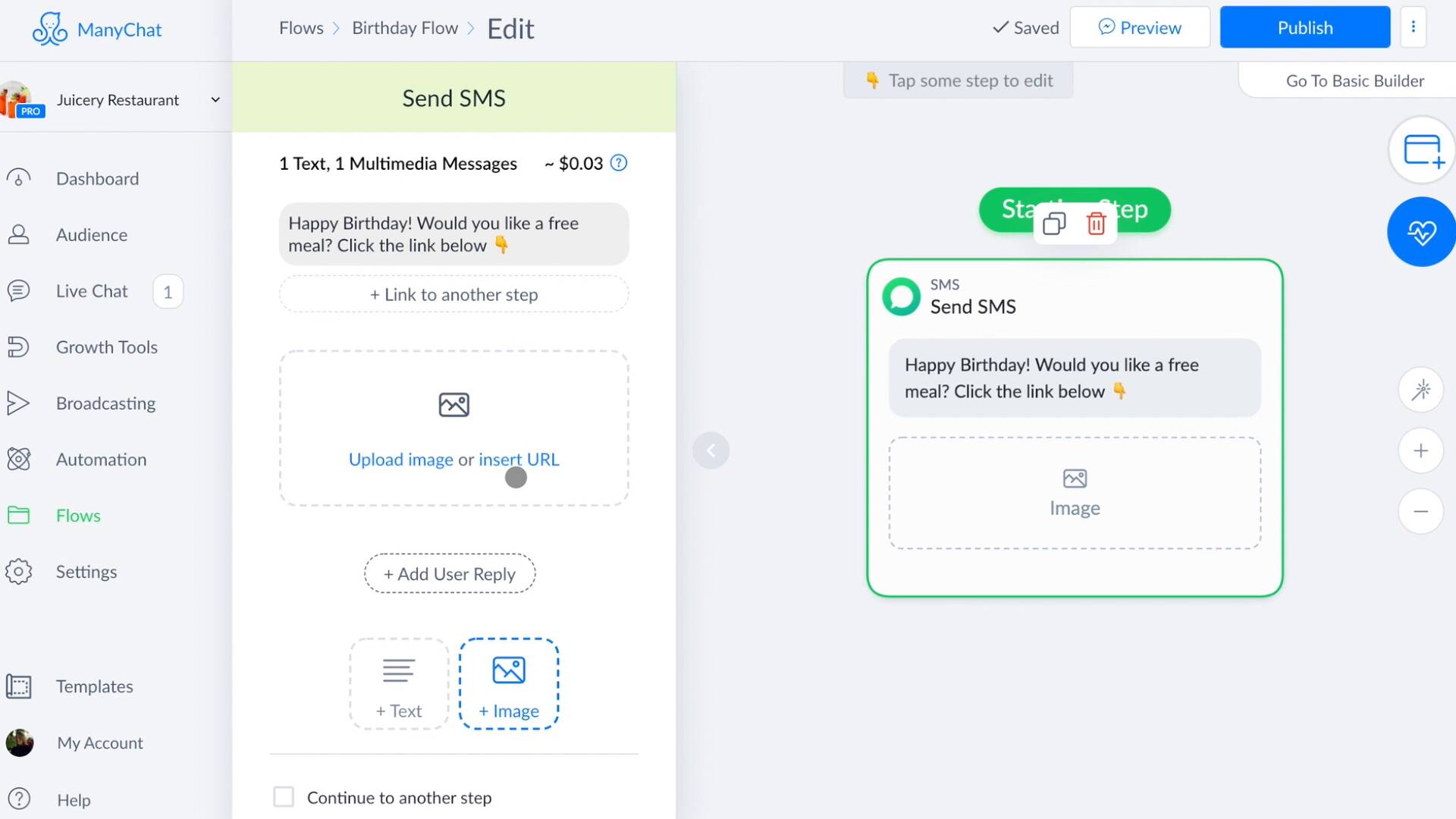It’s an understatement to say that smartphones have transformed the human experience — and it’s all happened rather quickly. Believe it or not, the first version of the iPhone reached consumer markets in 2007.
With the launch of this handheld device, it became possible for humans to fit entire worlds of opportunity and connection in their pockets. Take a step back to reflect on that tiny computer you bring everywhere with you for a moment.
Whether you want to message your friends, earn a college degree, shop for something, connect with your bank, or order food delivery, you can do it from your phone. And you can communicate with anyone on any continent.

An iPhone isn’t just “mass-market consumer technology”; it’s a remarkable and powerful invention that has quickly transformed the way people around the world connect with one another.
Most likely, if you’re a marketing leader, one question you’re facing is whether and how to incorporate multimedia messaging service (MMS) into your customer acquisition, retention, and growth strategy, and whether multimedia messaging fits into your overall goals.
In this guide, we’ll put some stakes in the ground to equip you with the critical thinking skills to make the best decisions for your MMS marketing strategy. Additionally, we’ll walk you through some key technical concepts, audience experience best practices, real-world examples, and messaging tips.
Let’s get started with a brief technical discussion before jumping into MMS marketing details.
MMS messaging: an overview
MMS is a communications technology that enables the exchange of digital content, such as photos, images, audio recordings, and videos, over a cellular network. When you text message a GIF, photo, or meme to a friend, you’re using MMS technology. The process of getting from point A to point B involves a phone-to-phone connection that runs through a network of validation and authentication protocols.
(You can read more about the precise technical details here if you are interested in learning more about the science of cellular connectivity. We’ve also embedded a video below, to help simplify some of the concepts and language.)
It is believed that MMS technology first became commercialized and accessible to consumers around 2004 or 2005 after it was created around 2002. With this piece of information, it’s important to keep in mind that MMS messaging is still a relatively new capability.
Not to mention, there are a few challenges that restrict business use cases, such as:
- MMS messaging is bandwidth-heavy. According to one recent study carried out in France, a large proportion of smartphone users don’t send MMS messages due to cost constraints. When they do engage with MMS communication, it’s for personal reasons such as sharing media with friends and family.
- There may be differences in device compatibility. This educational resource from IDC emphasizes that the ability to display a multimedia message depends on a device’s capabilities and that MMS messages are error-prone for some audiences.
- Bulk messages may overload servers. Multimedia messages are larger in file size than SMS (text messaging), which requires fewer data. IDC elaborates that it may be costly or technology-intensive to send the same multimedia message to the same recipient list.
- Connectivity challenges may arise. MMS requires, at a minimum, 3G connectivity. Message recipients may not have consistent access to predictable, high-speed bandwidth. As a result, they may receive error messages when opening messages.
- Security issues could arise. When it comes to digital media, bad actors continuously seek ways to wreak havoc and exploit systems. Vulnerabilities and consequential legal risks can arise without careful consideration and security infrastructure. To explore the topic of multimedia message security in greater depth, take a look at this watchdog research report, published by BBC, which describes large-scale vulnerability risks across a billion Android devices.
One way to stay educated and informed is to follow the work of the Open Mobile Alliance (OMA), which maintains standards for the mobile phone industry, including MMS specifications.
MMS marketing campaign planning tips
If you are interested in deploying a multimedia messaging campaign, you’ll need to evaluate your objectives from a few different angles. First, think about the user experience you’re looking to create, and whether this medium is the right fit for your audience. Also, make sure that your security and technical bases are covered so you don’t run the risk of creating unexpected technical issues for your business.
In this section, we’ll walk you through tips to consider when planning your campaign, coming away with a process to follow, as well as a tactical example to follow. Rather than creating your marketing strategy from a blank slate, you’ll have a clear understanding of how to get started, how to do it faster than if you were to start from scratch, and how to avoid costly mistakes.
Multimedia message campaign design process

Step 1: Before committing to MMS as a campaign medium, make sure that you define your campaign objectives. Whenever you communicate with audiences over their smartphones, you run the risk of potentially annoying them. Unlike email, which people can easily sort, delete, and control, multimedia messages reach someone’s text message inbox directly. Example campaign objectives for an MMS campaign include:
- Sharing a special promotion.
- Sending a thank you note.
- Sending a seasonal greeting.
- Sharing a special announcement.
Step 2: After you’ve defined the intent for your campaign, start thinking about frequency. Brands are finding that text messages can be a great way for companies to “keep a conversation going with consumers and foster a deeper relationship,” according to a recent article in Digiday.
At the same time, brands don’t yet have best practices for communication considerations such as message frequency.
“If you see brands starting to use SMS-like email with drip campaigns, automated flows, and tons of advanced logic, it will turn a highly personal channel into a spam inbox,” said Dennis Hegstad, co-founder of the texting platform LiveRecover, in an interview with Digiday. “If you treat SMS wrong, the customer sentiment can go from interested to neutral to negative, and interested in a competitor real quick.”
Keep in mind that in this particular example MMS isn’t text-based. There are many more complexities at play, and recipients may dislike receiving unsolicited, bandwidth-heavy communications. Given the relative “newness” of the channel, there are almost no guidelines for MMS messages.
Every audience is unique, so err on starting with less, testing results, and gathering feedback. Listen to your recipients closely. With every outreach campaign and MMS messaging especially, you need to understand what your audience prioritizes and values.
Step 3: Create a well-defined opt-in process. One way to avoid the potential risks of unwelcome MMS messages is to build a higher quality list. That means before sending out an unsolicited message, ask recipients if they would like to opt-in. Be clear about why you’d like to send an MMS message, how it’s different from SMS marketing, anticipated bandwidth, and device compatibility. You can also show people an example message, so audiences don’t feel caught off guard.
It may be helpful to share tips for enabling Wi-Fi as well as proactively educate audiences about bandwidth usage. This communication will be especially important for less technical audiences that may not know the difference between an SMS message, messaging app, or MMS message.
Step 4: Choose your campaign management software. One way to outsmart the technical, UX, and security pitfalls is to use software for MMS marketing deployment. The right program will help you create a high-performing multimedia strategy that aligns with the unique needs of the list that you created in step 3. It will also address interoperability challenges between iPhone and Android devices, for instance.
Ideally, the right management software will help you create a messaging app strategy that reaches a real person in a natural, organic way. Remember, despite your key performance indicators (KPIs), that people are more than clicks, taps, and swipes on the other side of the screen. They are smiles, laughs, tears, and agents of free-thinking.
Your software should help your multimedia message reach the “whole human” in a way that demonstrates empathy and respect. For example, take a look at ManyChat’s SMS tool, which was recently updated to include MMS capabilities. With this capability, you can integrate conversation data from chatbots and social media platforms with an MMS outreach strategy. You can also build your campaign from an integrated, omnichannel perspective.
Connect your MMS marketing strategy to business ROI
Before investing time in designing, deploying, and optimizing a campaign, it’s helpful to plan ahead to anticipate your business impact. A bit of forethought can also help you identify optimizations such as determining when to communicate using an SMS or an MMS message.
This customer story from ManyChat helps connect the concepts that we’ve discussed above into a straightforward, down-to-earth, and tactical view. Here’s a summary to help you skim the details:
- Don Marler, who runs a food truck, became so popular among his customers that he was having trouble keeping up with Facebook messaging.
- Marler wanted to encourage more location-based sales.
- He designed an omnichannel campaign that spanned SMS and Messenger from Facebook.
- He built an SMS list from the ground up by writing an organic post on Facebook, including a coupon offer that clicked through to Messenger, requesting information from users. Marler then segmented that SMS list by location.
Within two months of launching the SMS campaign, Marler saw a boost in sales that he was seeking. Results included:
- Over 90% open rate for text messages.
- More than $7,000 in additional revenue per month.
- About 5x return on ad spend on average.
- Increase of 30% total revenue for the business.
The campaign helped him reach his audience with messaging that made sense and that they cared about. Check out the video below to learn more about Marler’s experience with SMS and omnichannel marketing campaigns.
Last but not least
Keep in mind as you build your MMS messaging strategy that data privacy laws are in a constant state of flux around the world. For instance, if you run a giveaway program you’ll need to research where promotions or sweepstakes may be banned at both national and local government levels. It’s also important to work with partners and vendors that can stay on top of laws and help your business remain compliant.
Ready to give MMS a try?
SMS Disclaimer
This information is provided for educational purposes only and should not be relied upon as legal advice. Please always consult your own attorney before engaging in text marketing.







